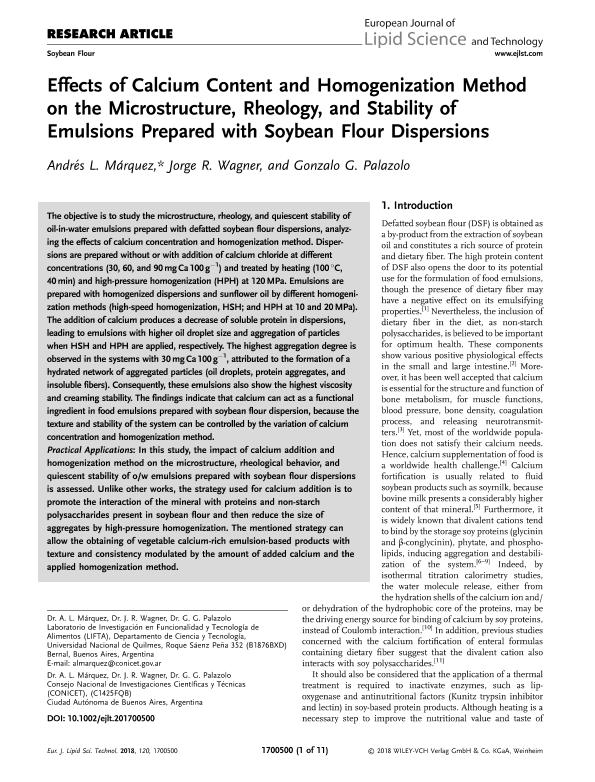Mostrar el registro sencillo del ítem
dc.contributor.author
Márquez, Andrés Leonardo

dc.contributor.author
Wagner, Jorge Ricardo

dc.contributor.author
Palazolo, Gonzalo Gastón

dc.date.available
2020-03-11T21:27:29Z
dc.date.issued
2018-07
dc.identifier.citation
Márquez, Andrés Leonardo; Wagner, Jorge Ricardo; Palazolo, Gonzalo Gastón; Effects of Calcium Content and Homogenization Method on the Microstructure, Rheology, and Stability of Emulsions Prepared with Soybean Flour Dispersions; Wiley VCH Verlag; European Journal of Lipid Science and Technology; 120; 7; 7-2018; 1-11
dc.identifier.issn
1438-7697
dc.identifier.uri
http://hdl.handle.net/11336/99237
dc.description.abstract
The objective is to study the microstructure, rheology, and quiescent stability of oil-in-water emulsions prepared with defatted soybean flour dispersions, analyzing the effects of calcium concentration and homogenization method. Dispersions are prepared without or with addition of calcium chloride at different concentrations (30, 60, and 90 mg Ca 100 g−1) and treated by heating (100 °C, 40 min) and high-pressure homogenization (HPH) at 120 MPa. Emulsions are prepared with homogenized dispersions and sunflower oil by different homogenization methods (high-speed homogenization, HSH; and HPH at 10 and 20 MPa). The addition of calcium produces a decrease of soluble protein in dispersions, leading to emulsions with higher oil droplet size and aggregation of particles when HSH and HPH are applied, respectively. The highest aggregation degree is observed in the systems with 30 mg Ca 100 g−1, attributed to the formation of a hydrated network of aggregated particles (oil droplets, protein aggregates, and insoluble fibers). Consequently, these emulsions also show the highest viscosity and creaming stability. The findings indicate that calcium can act as a functional ingredient in food emulsions prepared with soybean flour dispersion, because the texture and stability of the system can be controlled by the variation of calcium concentration and homogenization method. Practical Applications: In this study, the impact of calcium addition and homogenization method on the microstructure, rheological behavior, and quiescent stability of o/w emulsions prepared with soybean flour dispersions is assessed. Unlike other works, the strategy used for calcium addition is to promote the interaction of the mineral with proteins and non-starch polysaccharides present in soybean flour and then reduce the size of aggregates by high-pressure homogenization. The mentioned strategy can allow the obtaining of vegetable calcium-rich emulsion-based products with texture and consistency modulated by the amount of added calcium and the applied homogenization method. Soybean flour dispersions are heated in the presence of different calcium concentrations and then homogenized by high-pressure homogenization. Emulsions are prepared with homogenized dispersions and sunflower oil by high-speed or high-pressure homogenization. The addition of calcium leads to aggregation of particles in emulsions homogenized at high pressure; and good quiescent stability is achieved in emulsions with moderate calcium content.
dc.format
application/pdf
dc.language.iso
eng
dc.publisher
Wiley VCH Verlag

dc.rights
info:eu-repo/semantics/openAccess
dc.rights.uri
https://creativecommons.org/licenses/by-nc-sa/2.5/ar/
dc.subject
CALCIUM
dc.subject
DEFATTED SOYBEAN FLOUR
dc.subject
EMULSIONS
dc.subject
HIGH-PRESSURE HOMOGENIZATION
dc.subject
HIGH-SPEED HOMOGENIZATION
dc.subject.classification
Alimentos y Bebidas

dc.subject.classification
Otras Ingenierías y Tecnologías

dc.subject.classification
INGENIERÍAS Y TECNOLOGÍAS

dc.title
Effects of Calcium Content and Homogenization Method on the Microstructure, Rheology, and Stability of Emulsions Prepared with Soybean Flour Dispersions
dc.type
info:eu-repo/semantics/article
dc.type
info:ar-repo/semantics/artículo
dc.type
info:eu-repo/semantics/publishedVersion
dc.date.updated
2020-03-03T15:04:41Z
dc.journal.volume
120
dc.journal.number
7
dc.journal.pagination
1-11
dc.journal.pais
Alemania

dc.journal.ciudad
Weinheim
dc.description.fil
Fil: Márquez, Andrés Leonardo. Consejo Nacional de Investigaciones Científicas y Técnicas; Argentina. Universidad Nacional de Quilmes. Departamento de Ciencia y Tecnología. Laboratorio de Investigación en Funcionalidad y Tecnología de Alimentos; Argentina
dc.description.fil
Fil: Wagner, Jorge Ricardo. Consejo Nacional de Investigaciones Científicas y Técnicas; Argentina. Universidad Nacional de Quilmes. Departamento de Ciencia y Tecnología. Laboratorio de Investigación en Funcionalidad y Tecnología de Alimentos; Argentina
dc.description.fil
Fil: Palazolo, Gonzalo Gastón. Consejo Nacional de Investigaciones Científicas y Técnicas; Argentina. Universidad Nacional de Quilmes. Departamento de Ciencia y Tecnología. Laboratorio de Investigación en Funcionalidad y Tecnología de Alimentos; Argentina
dc.journal.title
European Journal of Lipid Science and Technology

dc.relation.alternativeid
info:eu-repo/semantics/altIdentifier/url/https://onlinelibrary.wiley.com/doi/full/10.1002/ejlt.201700500
dc.relation.alternativeid
info:eu-repo/semantics/altIdentifier/doi/http://dx.doi.org/10.1002/ejlt.201700500
Archivos asociados
